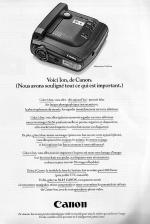|
Canon RC-251 (Ion) |
Manufactured or assembled in Japan from 1988 to (After) 1989.
Index of rarity in France: Rare (among non-specialized garage sales)
Inventory number: 10562
See the complete technical specifications
Chronology of cameras Canon
The Ion (Interactive Online Network) more closely resemble the Millennium Falcon than a camera. They have the peculiarity of being a frame-by-frame limited VCR. A floppy disk allows recording frames as an analog magnetic signal.
The first, chronologically speaking, was the RC-250.
First article presenting this camera, by Phot'Argus, in November 1988, following the Photokina.
Canon establishes itself very solidly in photovideo with four shooting cameras and a whole range of peripherals. As with other brands, the consumer orientation of some equipment is muted by the NTSC standard, which limits access to professionals and institutional users.
This ultra-thin "jumelle" type camera is the big novelty of the brand. So new that the big boss cautiously brought his own to the press conference, and promptly took it away as soon as the conference was over. Few are those, like Gérard Bouhot, who were "Portraitized" in private demonstration, by that of Hiro Hashimura, Manager of Amsterdam... Despite its miniaturization, this RC-250 is both a recorder and a player, which allows it to be connected to a television (NTSC!) without further ado to view the images. Unused views can be deleted to free up space on the photo diskette.
50 views can be recorded, according to the Hi-Band standard.
1/2" CCD sensor with 412,000 pixels.
Fixed-focus lens 11 mm f/2.8 ensuring minimal sharpness from 1 meter.
Macro position allowing photography from 30 cm away from the CCD surface.
Direct viewfinder with adjustable eyepiece from -4 to +2 diopters.
Programmed central shutter offering automatic speeds from 1/30 to 1/500 s.
X sync at 1/125 s (the built-in flash automatically activates when the brightness drops below IL 8).
Automatic exposure adjusted by a non-TTL silicon cell, coupled from IL 8 to 18 (equivalent sensitivity 100 ISO).
Backlight correction +1.5 IL.
Automatic white balance by an external cell.
Frame-by-frame shooting, or up to 3 frames/second max.
10-second timer.
Data display on LCD (track number, shooting mode, status of the photo diskette and battery).
Recall of over and underexposure in the viewfinder by LED.
A fully charged battery can provide autonomy for 500 flash-free shots, or 10 minutes of playback.
Other interesting functions offered by the RC-250: the drive rotation stops automatically if the same track (image) has been continuously played for more than 2 minutes (with battery BP-4P) or 15 minutes (with the BA-24P mains charger), in a natural concern to preserve energy. Just press the shutter release to reactivate playback.
Erasure occurs with each press of the shutter release when the corresponding button is activated (the photo-video system does not allow the recording of an occupied track, so it is necessary to erase the track(s) to be reused beforehand, for safety). And all this weighs only 525 grams with the battery (available in black or white).
During long playback, an AC adapter cable is used (false battery at one end, receptacle in the center receiving the battery to be recharged, and from this receptacle, a cable to be plugged into the antenna of a television... NTSC).
At its release, the RC-250 joined three existing models of video cameras (RC-407, RC-701, RC-760), which were higher-end. These have a completely different design and do not fit into the Ion series.
| Europe | America | Japan | Years | Lens | CCD sensor (px) | Standard | |
| RC-251 (ION) |
RC-250 (XAP SHOT) |
RC-250 (Q-PIC) |
1988-90 | 2,8/11 | 200 000 | NTSC | |
| RC-260 (ION) | / | / | 1991 | 2,4/9,5 | 230 000 | PAL | |
| / | RC-360 | RC-360 |  |
1992 | 2,4/5,9 | 260 000 | NTSC |
| / | RC-570 | RC-570 |  |
1992 | 2,5-2,7/8-24 | 410 000 | NTSC |
| RC-560 | / | / |  |
1992 | 2,5-2,7/8-24 | 410 000 | PAL |
The name Ion was used only in Europe.
__________
The lens 2.8/11 mm corresponds to a 60 mm in 24 x 36 format.
During its launch, this camera cost 5900 francs.

Interesting links or bibliography :
 |
Add a link or element of bibliography, a picture taken with this camera, a picture of box or an ads about this camera
Your photos taken with the same camera:
Cameras from Ebay France (Canon) (Uploaded each 3 hours)




































